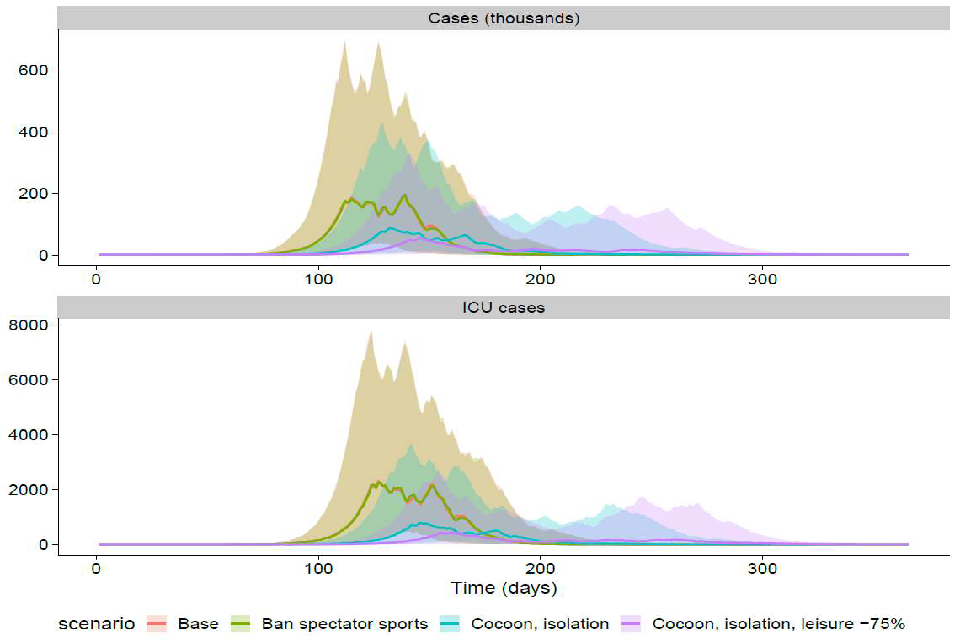The impact of banning sporting events and other leisure activities on the COVID-19 epidemic, 11 March 2020
Updated 13 May 2022
Nick Davies, Roz Eggo, Adam Kucharski and John Edmunds on behalf of Centre for Mathematical Modelling of Infectious Diseases (CMMID) COVID-19 Modelling Team
London School of Hygiene and Tropical Medicine
11 March 2020
1. Background
There is currently much interest in banning mass gatherings as a way to mitigate the COVID-19 epidemic. We assessed the likely impact of these measures.
2. Methods
We use the LSHTM age-structured stochastic transmission dynamic model. We look at the impact of 2 different policies:
- Banning all major sporting events
- Reducing all leisure-related contacts (pubs and bars, restaurants, cinema, and so on) by 75%
To estimate the impact of banning sporting events, we used estimates of the cumulative attendance at these events across the UK in 2019. The average person in the UK makes 10.9 contacts per day, 3.7 of which are ‘other’, of which 1.8 are ‘leisure’ [footnote 1]. Given a UK population of 67,530,172 in 2019 (same year as sports analysis), this means there are 250,536,938 ‘other’ contacts per day. Attendance at UK sporting events is 75,100,000 per year, which works out to 205,753 per day. If individuals make 5 contacts per event, this is 1,028,767 contacts per day. Accordingly, banning sporting events should reduce ‘other’ contacts by 1,028,767 out of 250,536,938 which equals 0.41%. We reduced ‘other’ contacts by this amount for the ‘banning spectator sports’ scenario.
Conversely, reducing ‘leisure’ contacts by 75% should reduce ‘other’ contacts by (0.75 multiplied by 1.79) divided by 3.71 which equals 36.2%. We reduced ‘other’ contacts by this amount for the ‘clampdown on leisure activities’ scenario.
Both of these strategies are applied to:
a) an uncontrolled epidemic;
b) a partially mitigated epidemic in which case isolation and cocooning of the elderly (aged 65 plus) are in place for 7 months, starting from mid-March.
3. Results
The figure below shows the impact of the different measures. Banning attendance of sporting events has an imperceptible impact on the epidemic.

Figure 1. Impact of different measures. Median epidemic lines are given by solid lines, for the different scenarios, and shaded areas give associated Confidence Intervals.
The table below shows the impact of the different policies. It is clear that there is a negligible impact of banning attendance at sporting events, but that a reduction in leisure activities can reduce peak height and total numbers of cases.
| Table | Scenario | Median (IQR) |
|---|---|---|
| Peak week: cases | Base 20 | (17 to 24) |
| Peak week: cases | Ban spectator sports | 20 (17 to 24) |
| Peak week: cases | Cocoon, isolation | 23 (20 to 33.5) |
| Peak week: cases | Cocoon, isolation, leisure -75% | 25.5 (20 to 36.5) |
| Peak week: icu | Base | 21 (19 to 25.8) |
| Peak week: icu | Ban spectator sports | 21 (19 to 25.8) |
| Peak week: icu | Cocoon, isolation | 25 (22 to 34.8) |
| Peak week: icu | Cocoon, isolation, leisure -75% | 27.5 (22 to 37.8) |
| Peak height: cases | Base | 5440000 (2880000 to 6650000) |
| Peak height: cases | Ban spectator sports | 5430000 (2860000 to 6630000) |
| Peak height: cases | Cocoon, isolation | 2820000 (2050000 to 4980000) |
| Peak height: cases | Cocoon, isolation, leisure -75% | 2370000 (1870000 to 3690000) |
| Peak height: icu | Base | 55900 (29900 to 72900) |
| Peak height: icu | Ban spectator sports | 55400 (30000 to 72800) |
| Peak height: icu | Cocoon, isolation | 21300 (14800 to 37300) |
| Peak height: icu | Cocoon, isolation, leisure -75% | 21700 (15400 to 27400) |
| Total: cases | Base | 26400000 (22100000 to 28400000) |
| Total: cases | Ban spectator sports | 26400000 (22100000 to 28400000) |
| Total: cases | Cocoon, isolation | 20500000 (19100000 to 24200000) |
| Total: cases | Cocoon, isolation, leisure -75% | 20600000 (19400000 to 21200000) |
| Total: icu | Base | 287000 (226000 to 325000) |
| Total: icu | Ban spectator sports | 286000 (225000 to 326000) |
| Total: icu | Cocoon, isolation | 165000 (157000 to 197000) |
| Total: icu | Cocoon, isolation, leisure -75% | 175000 (157000 to 192000) |
4. Discussion
Banning sporting events has a negligible impact on the epidemic. Reducing all leisure contact, which mainly occurs in pubs, bars, restaurants and cinemas would have a much larger (though still modest) impact on the epidemic. Many individuals are likely to choose to avoid such settings anyway, as they perceive them to be risky [footnote 2]
5. References
-
Mossong J, Hens N, Jit M, Beutels P, Auranen K, Mikolajczyk R, Massari M, Salmaso S, Tomba GS, Wallinga J, Heijne J, Sadkowska-Todys M, Rosinska M, Edmunds WJ. Social contacts and mixing patterns relevant to the spread of infectious diseases. PLoS Med. 2008 Mar 25;5(3):e74. ↩
-
Sadique MZ, Edmunds WJ, Smith RD, Meerding WJ, de Zwart O, Brug J, Beutels P. Precautionary behavior in response to perceived threat of pandemic influenza. Emerg Infect Dis. 2007 September;13(9):1307-13. ↩
